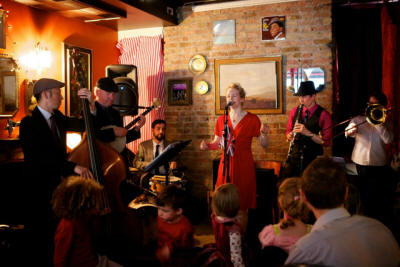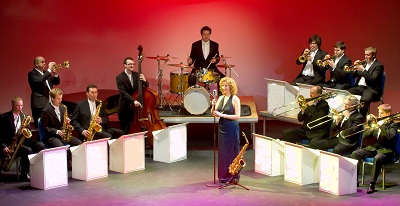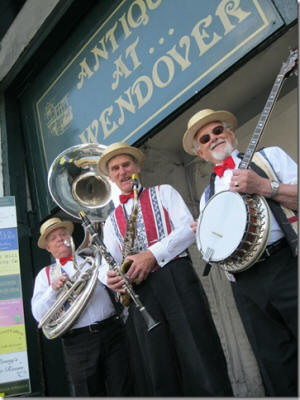Jazz Bands - for your Event
Live Music Booking Service for Your Party, Wedding or Event from - Midsummer Music - the music people
To see available Jazz Bands
select your County or Location
About Jazz Bands
The Jazz Band pages list bands that are available to perform in your area. They are particularly appropriate for wedding receptions and parties. At weddings, jazz bands can play for the drinks reception, during the meal, and for the evening reception. Of course, you would want different styles of band for each part of the day, but with the help of our website you can select what is most appropriate for you. To find out more about them, read on:
 Jazz
Bands cover just about any size of jazz group from a duo to a 20 piece big band.
The right jazz band for you to hire depends on your event and whether you are
looking for wedding music ideas, corporate event entertainment or music for a
garden party etc. The cost of a jazz band tends to increase with the number of
musicians, but this is by no means always the case, so look at the price
indications on the page of jazz bands who can be booked for events in your area.
Jazz
Bands cover just about any size of jazz group from a duo to a 20 piece big band.
The right jazz band for you to hire depends on your event and whether you are
looking for wedding music ideas, corporate event entertainment or music for a
garden party etc. The cost of a jazz band tends to increase with the number of
musicians, but this is by no means always the case, so look at the price
indications on the page of jazz bands who can be booked for events in your area.
When searching for wedding entertainment ideas, consider a jazz band for your evening entertainment, perhaps including swing for some dancing. Or perhaps trad jazz of the afternoon reception. For corporate event planners the kind of jazz band that might be suitable depends on the event type and whether they will be playing indoors or out.
Use the drop down box at the top of the page to select the county where your venue is and see the musicians who are available to perform there.
To show the extremes of jazz bands, here is some general information about the genre, from Trad, through Big Bands to Jazz Rock Fusion. But be sure to brows our pages of bands and listen to their music, to find the style that you like, or just send us an enquiry letting us know the kind of jazz you enjoy.
A bit about Traditional Jazz - New Orleans / Chicago
Trad jazz bands are particularly good if you want the band to play outdoors during the wedding drinks reception. They originated as outdoor bands. Here is a bit about them:
The beginnings of what, these days, is generally referred to as Trad. was in the black society of New Orleans with the marching band, which constituted one of the few reliable sources of paid employment for black musicians. Recordings of marching bands are rare; the earliest date from 1945, by which time the influence of jazz had undoubtedly transformed the original style. Many jazz musicians served their apprenticeships in the New Orleans marching bands, which determined the choice of the trumpet, trombone and clarinet as the principal melodic instruments in early jazz. They also played as funeral bands, where Solemn music accompanied the mourners on the way to the cemetery. To celebrate the deceased's life, spirited music was played with characteristics of Ragtime - an idiom derived from band marches in the first place. It was played during the return from the graveyard and at the all-night wake that followed.
 In
February 1917, a group of white musicians from New Orleans, well known for their
performances in Chicago during the previous year, made the first jazz phonograph
recordings in New York. Much of the Original Dixieland Jazz Band's work is
rhythmically stilted (a fundamental style described as 'corny' by later
musicians) and lacks the prominent 'blue notes' of early black jazz.
In
February 1917, a group of white musicians from New Orleans, well known for their
performances in Chicago during the previous year, made the first jazz phonograph
recordings in New York. Much of the Original Dixieland Jazz Band's work is
rhythmically stilted (a fundamental style described as 'corny' by later
musicians) and lacks the prominent 'blue notes' of early black jazz.
The term 'Dixieland' is generally used for the New Orleans style as adapted by white musicians. Apart from the Original Dixieland Jazz Band, another successful white group was the New Orleans Rhythm Kings, who were active in Chicago in the early 19208. Both bands modeled their instrumentation on the smaller black New Orleans ensembles, with a three-instrument 'front line' (cornet, clarinet and trombone), and a supporting rhythm section (including piano and drums). The popularity of new dance styles helped jazz to develop from the march-like tread of its early days into the snappy, syncopated music so characteristic of what F. Scott Fitzgerald dubbed 'The Jazz Age'.
The first black jazz cornet player to make successful recordings developing style was Joe'King'Oliver (1885-1938),whose career also began in the New Orleans brass bands and at Storyville. After World War I he joined the migration northwards and found work in Chicago, where he formed his Creole Jazz Band. Oliver's Creole Jazz Band perfected a style of New Orleans jazz in which the three (or four) front-line instruments participated in the basic melody. In comparison with the new swing-band style that developed in the early 1930s, Oliver's music seemed old-fashioned and was largely ignored. The clarinet was made popular as a jazz instrument by Johnny Dodds and several other New Orleans performers, including Jimmie Noone (1895-1944) and Sidney Bechet (1897-1959). In the recordings made by his own band, The Red Hot Peppers (formed in 1926), Morton conducted bold experiments with musical structures. By the 1940 the 'New Orleans style, Chicago style, Kansas City style, New York styles were generically dubbed 'JELLY' roll style: and was overtaken by the newer styles of jazz, thought there was revival of New Orleans jazz in the late 1940s where its ethnic roots were again appreciated.
About 'Big Bands'
Although there are some Big Bands on our website, they are not suitable for most weddings or corporate events, not least because of cost and the size of venue that is needed. But much of the repertoire can be played in a more limited way with a jazz quartet and really quote well with a jazz quintet or sextet comprising appropriate instruments. Here is a little of the long history of the Big Band:
Both Oliver and Morton, masters of the old jazz style, became unpopular after 1929 because their musical language had little in common with the big-band idiom that supplanted it. The music of the Swing Era sprang from a different source: the dance band. The dance bands continued a lively popular-music tradition that went back to successful ragtime orchestras such as that led by James Reese Europe (1881—1919). The sonorities produced by these instruments had a closer association with classical music than with New Orleans ensemble jazz, and violins in particular were retained as a fundamental section of many later dance bands.
As the harmonic idiom of jazz became more complex, the viability
of the New Orleans approach diminished: the Dixieland and swing-band styles were
essentially incompatible. White dance bands achieved greater commercial success,
although several black groups were undoubtedly their superior in artistic terms.
Initially inspired by the work of Nick LaRocca with the Original Dixieland Jazz
Band, Beiderbecke had formed a group modeled on the New Orleans Rhythm Kings in
Chicago in 1924. Symphonic jazz also became a vehicle for the growing
nationalist trend in American classical music. By far the most important
precursor of big-band jazz was the ensemble led by black pianist Fletcher
Henderson (1897-1952). The energetic trading of riffs between reeds and brass in
rapid call-and-response patterns became one of the most appealing features of
big-band jazz.
Goodman and his band were the hottest property in the ensuing craze for the 'new' (actually several years old) swing music. Recognizing Henderson's contribution to his phenomenal success, however, Goodman secured his services as the band's full-time arranger in 1939. Links between the newly respectable jazz and classical music were furthered by Goodman's blossoming career as both jazz and classical clarinetist. Hampton's band, which undertook numerous worldwide tours from the 1950s onwards, is the longest surviving big band in the history of jazz.
During the 1930s the popularity of commercial white bands from New York masked the fact that the best music in the swing-band idiom was already being produced by black ensembles - by now a depressingly familiar state of affairs at that time. The Basic band established itself at Henderson's former haunt, the Roseland Ballroom, in 1937. Big bands managed to survive changing fashions — if at times precariously. So-called 'progressive jazz' was developed by Stan Kenton (1911—79), whose Innovations in Modern Music Orchestra explored an intriguing but sometimes pretentious and stilted mixture of big-band jazz and pseudo-classical music. Affection for genuine big-band jazz doggedly persisted and when Benny Goodman (fronting a much younger band) played at Carnegie Hall on 17 January 1978 to mark the fortieth anniversary of his historic first appearance there, the band's energetic performance of Henderson's arrangement of Morton's King Porter Stomp still brought the house down.
About Jazz-rock Fusion and other modern jazz styles
Not as comfortable to listen to at a wedding as a Swing Band, modern jazz can be challenging, but exciting too. It can be great party music if jazz is your scene.
Jazz-rock introduced new instruments to the genre, featuring the electric guitar, electric Fender bass guitar and electric piano in, for example the 1969's albums 'In a Silent Way' and 'Bitches Brew' that borrowed instruments and techniques from rock and introduced the concept of jazz-rock fusion, a style that won a vast new audience in the 1970s
In 'Spanish Key', a rock beat and bass riff combine to support improvisation based on scales (an approach recalling Davis's earlier modal jazz); the music was controlled by spontaneous signals from the leader. Bitches Brew amply repaid Columbia records and Davis for their jointly conceived gamble by soon becoming one of the best-selling albums in jazz history. This emphasis on extended free improvisation reflected the continuation of a quintessential aesthetic preoccupation of jazz, in stark contrast to the largely pre-composed nature of contemporaneous rock music. In spite of his commercial success, Hancock continued to take his work as an acoustic (non-electric) jazz pianist seriously. By moving between electric and acoustic jazz, Hancock typified the dual and broadminded approach of many musicians working in the aftermath of the initial fusion boom.
Chick Corea had devoted his energies to a restrained form of free jazz while he was also participating in Davis's early fusion bands. Commercial success as a record executive has not sidetracked him from playing acoustic jazz, and his resourceful interpretations of standards by George Gershwin (1991) and Duke Ellington (1993) are a notable contribution to the numerous contemporary tributes to jazz's past masters.
Jarrett's extended solo improvisations succeeded in blending elements of jazz, folk music and classical styles, and the ECM recording of his performance at Cologne in 1975 sold over two million copies. In America, leading bluegrass instrumentalists have adopted the techniques of both acoustic jazz and fusion in a tuneful and buoyant idiom dubbed jazz-grass' or 'new grass'. As interest in acoustic jazz grew during the 19805, a wave of 'neo-classicism' aimed to keep earlier jazz styles in circulation and encourage the preservation of a permanent repertory of masterpieces by perennially acclaimed composers such as Ellington. The most persuasive advocate of a return to traditional jazz values has been American trumpeter Wynton Marsalis. Like Miles Davis, he had both a classical training, at the Juilliard School of Music in New York, and an apprenticeship in jazz, fundamentally different outlook from Davis and openly rejected fusion, which he regarded as an artistic betrayal. In America, generous state and industrial sponsorship for jazz remains the envy of musicians from other countries: the Jazz Masterworks Orchestra of the Smithsonian Institution, Washington, DC, a group founded in 1991, was subsidized by over $300,000 from Congressional funds, and private endowments of jazz education programs have in several cases topped the million-dollar mark. Today's music is characterized by a diversity style mixing elements of free jazz, the avant-garde, fusion, crossover and traditional jazz that defy easy categorization.
Resources
Here are some interesting resources on the history and performance of Jazz:
HISTORY OF JAZZ
FROM THE VIEWPOINT OF FIDDLE PLAYER
Origins of Jazz
JAZZ AND FOLK
MUSIC.
Formal notation of
jazz
The origins of
spirituals in jazz
Printed music
versus tradition in jazz
Rhythmic Elements
of Jazz
Emphasis in Jazz
Rhythms
Emotions and Jazz
Rhythms
Sections of a Jazz
Band
Jazz Pollyrhythm
The Big Jazz Band
- the Jazz Orchestra
The Standardised
Jazz Orchestra
Commercial Jazz
Band Orchestration
The Psychology of
Jazz Band Syncopation
Tap Dancing & the
Jazz Band
The Jazz Band &
Indo Jazz Fusion
Blues and
Transforming Jazz into an Art Form
The Jazz Band in
the American Psych
Bebop & Hard Bop Jazz
Jazz Big Bands
Duke Ellington - Jazz Composer
Free
Jazz & Modern Jazz
Jazz-Rock Fusion
Jazz Timeline
Louis Armstrong - Instrumentalist and Vocalist
Miles Davis - the great inventor
Jazz from New Orleans to Chicago
Ragtime